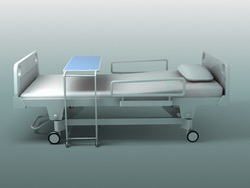The maintenance of medical beds is a serious matter in hospitals. At any time a patient may be in need of intensive care, and one way to provide that without being aggressive on medications is through providing comfortable beds. It's just as important to have complete accessories and medical beds parts in order to make sure the patient receives maximum comfort. Occasionally, the equipment might break and, for that reason, medical beds parts should be available in stock or in stores. The following are considerations when choosing the proper medical accessories for the patient's needs, and discusses the importance of availability when it comes to maintenance.

Accessories
There is any number of accessories that come with hospital beds. Some of the most common accessories are, bed straps, bed railings, overbed tables, hand grips and controllers. There are others, which are less popular, and less used, but still equally important. On top of that, there are so many manufacturers and brands of medical equipment that making the selection process can be difficult. In order to ensure that the patients get the maximum care they need, the hospital administrators must be very keen when choosing what types of equipment and accessories are really necessary.
Another reason for careful selection is that most medical beds parts will be hard to come by. The hospital administrators must assume that not all parts will be instantly available, even if the parts are sold nearby. For that reason, the hospital must purchase not only a required number of medical beds, but also stock enough medical beds parts.
Medical beds parts and their uses
Different medical beds parts have different purposes, but all things considered, the goals remain the same: the comfort and convenience of the patient. The following is a list of various known medical beds parts and their benefits to patients:
- Medical bed restraints: Typically, bed restraints are in the form of bed straps, used to make sure that the patient doesn't hurt himself or hurt others. For the most part, restraints are used to prevent patients from falling off the bed.
- Bed railings: Bed rails, as surprising as it sounds, are a type of medical restraint. These are restraints used for the sole purpose of keeping the patients from accidentally falling out of the bed, which can cause further injury.
- Overbed tables: It's very likely that patients confined in hospitals will not be allowed to get up from bed, for all kinds of reasons. This makes eating difficult. So having overbed tables is the next best thing for patients.
- Hand grips: Nurses, caregivers or attendants will not always be there to help the patient when he wakes up, wants to sit up and needs something. In situations like this, the patient will have to do it alone. The least caregivers can do for the patients is to give them a way to help themselves, such as bed grips to help them when sitting up.
- Bed controllers: Perhaps one of the most expedient medical beds parts is the controller. It allows the patient or the caregiver to readjust the bed for comfort. It's also a quick way to call a resident nurse to see to the patient's needs.
